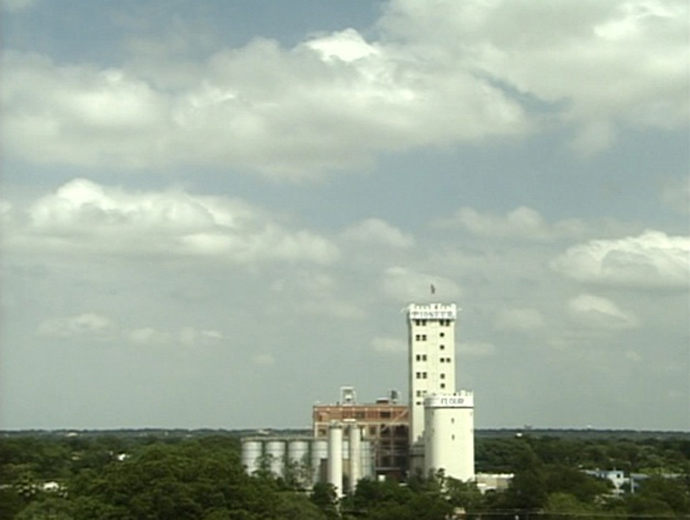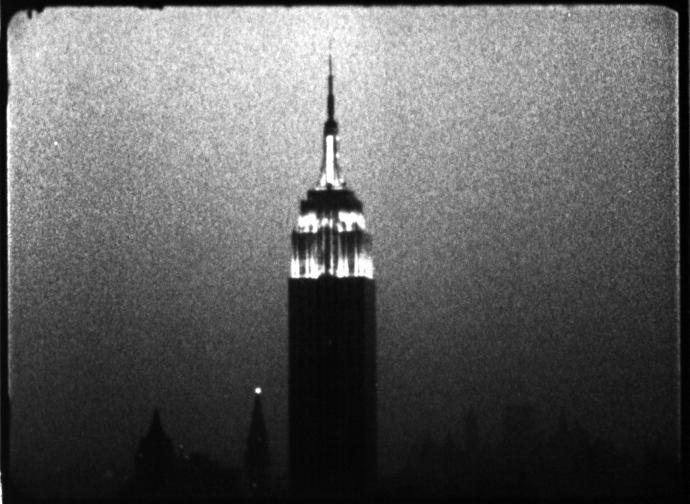from pastelegram.org, June 2011 – April 2014
Chris Sauter: Empire
Après moi, le déluge.
— attributed to King Louis XV
It’s hard to say that one institution is following another when it comes to mounting exhibitions devoted to Andy Warhol. Warhol’s name recognition is such that it seems imperative for a museum to keep him in the lineup to generate public interest (if you don’t believe me, Google it). To that point, the McNay Art Museum of San Antonio, Texas has opened Andy Warhol: Fame and Misfortune as its special exhibition. Mostly a museum of modern art, the McNay follows its recent tradition of incorporating local contemporary artists’ work in conjunction with its permanent collection and special exhibitions. In conjunction with the Warhol show, the McNay is showing Chris Sauter’s 2006 video Empire just outside of its Warhol exhibit.
Sauter’s Empire is an eight-hour long shot of the C.H. Guenther & Sons’ Pioneer Flour mill tower just south of downtown San Antonio, locally referred to as the “Tower of Flour.” The camera never moves and the building never changes. The white, narrow and castle-like tower stands against a typical blue south Texas sky with not much else going on. Cloud movement, a passing bird and the waving of an American flag are about all the visual stimuli there is, which makes this video—like much video art—boring. But the Pioneer Flour building is a landmark for San Antonians living just south of downtown.

Chris Sauter, Empire, 2006; video, 8 hours; courtesy of the artist.
Sauter’s video features the mill rising above the tree line. These trees shade the yards of the surrounding century-old houses that increase in size and grandeur the closer they are to the tower and the San Antonio River. It is a monument to the powers and rewards of industry, labor and will. The relationship of industry and nature is found in many of Sauter’s works, especially the conflicts of the rural agrarian with the urban industrial. Sauter’s video is eight hours long, the length of a typical work shift. An endurance test for any of us. Above all, the video captures, freezes, makes static a sliver of time’s forever-forward trajectory.
Presented in concert with the McNay’s Warhol exhibit, Sauter’s video takes on further connotations. The first work you see upon entering the Warhol exhibit is, in fact, his famed eight-hour long film Empire (1964). While Sauter’s video is actually an eight-hour video recording, Warhol’s film is a six-and-a-half-hour film recording of the Empire State Building, slowed to span an eight-hour period. Warhol’s static shot took place at night, with the only perceptible changes being in the building’s lights. The structure is an icon of American popular culture and commerce. An office building built at the dawn of the Great Depression, it stood for forty years as the world’s tallest building (a status it was to lose eight years after Warhol’s film). When King Kong climbed and fell from the building in the 1933 film, he played the primitive foil to the building’s symbolism of technology and industry.
So here are similarities between the two works: both are impossibly long to watch—nothing really happens in either—and both are records of a physical testament to the grandeur of industry. Time is a resource that both of these works exploit. It goes without saying that Sauter’s video is an acknowledged re-imagination of Warhol’s original and that this is why the McNay paired Sauter’s video with the Warhol exhibition. But the similarities or differences of these two specific artworks are not what interests me. I am more concerned with Warhol’s unremitting influence.

Andy Warhol, Empire, 1964; 16mm film, black and white, silent, 8 hours and 5 minutes at 16 frames per second; ©2012 The Andy Warhol Museum, Pittsburgh, PA, a museum of Carnegie Institute. All rights reserved. Film still courtesy of The Andy Warhol Museum.
Two generations have grown up under the influence of Warhol’s aesthetics, mannerisms, writings and style, whether we recognize it or not. This influence on artists and their artwork is absolutely immeasurable, but here are a few specific examples: Douglas Gordon’s Bootleg (Empire) (1997) and 24 Hour Psycho (1993), Mary Ellen Carroll’s Federal (2003), Wolfgang Staehle’s Empire 24/7 (1999-2004), and Chris Sauter’s Empire (2006). All of these works have been shown in conjunction with—or described with reference to—Warhol’s Empire. These works are direct responses to Warhol’s film, each of them a slight modification of the theme, and all a little bit self-conscious. Each one uses time itself as a means to an end. In his 2009 book What Is Contemporary Art? Terry Smith uses some of these examples, along with Warhol, to point out that time-based approaches are one focal point for contemporary artists.1 Smith creates a generous argument for contemporary artists’ obsessions with their own time or place. But what about so many artists’ obsessions with a previous time that is not their own?
Smith asks, what is contemporaneity?; how is it defined?; how has the art historical period of modernism been completed? But Smith, as a historian, blurs the lines of distinction he tries to set up between the then-and-now. What Smith glosses over, by combining his contemporary artists with Warhol, is the overriding inability to break with the near past. Anchoring the aims of contemporary artists to Warhol, whether true or not, keeps creative stagnation alive and well. A contemporary mode of working could be rearrangement. But, remixing the ideas and rehashing the designs of last century’s artists does little more than reinforce their influence. Sauter’s video does just that: it reiterates the essence of influence. Artists, writers, and curators will either embrace or negate Warhol’s reach, and even irony and disinterest seem Warholian in retrospect. Coming after Warhol in history is a mode of working.
- 1. Terry Smith. What is Contemporary Art? (Chicago: University of Chicago Press, 2009).